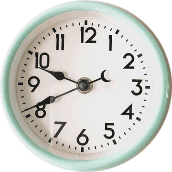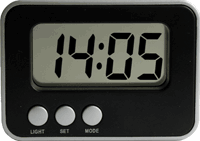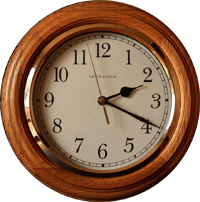Clock
A clock is a device used to measure, keep, and indicate time. There have been many different types of clocks (or time-measuring devices) throughout history, such as sundials, water clocks, mechanical clocks, spring-driven clocks, atomic clocks, and more.
A number of different types of clocks are still used today, which have varying degrees of accuracy, but for everyday purposes, we mostly just need to be familiar with analog and digital clocks.
Analog vs. digital clocks
An analog clock is a type of clock that indicates time using a traditional clock face with moving hands. In contrast, digital clocks use a numeric representation of time where a colon (:) separates the current hour and minute. Some digital clocks also display the current second, but there are many where each passing second is indicated by the colon blinking, without any indication of the current second.


The digital clock above uses a 24-hour format where midnight is 00:00 (the 24th hour) and time counts up from 0 through the 23rd hour (11 PM). Digital clocks can also use a 12-hour format where midnight is 12 AM, noon is 12 PM, and the hours between each count up from 1-11. Digital clocks are very common today as part of phones, computers, and other devices. When buying a watch, a person also has a choice between an analog and a digital watch. Most people can likely read a digital clock more quickly than they can an analog clock.
How to read an analog clock
In order to read an analog clock, we first need to understand its different parts. Refer to the figure below.

The twelve numerals and the large tick marks written on the clock above represent the hours, 1-12. There are 60 marks in total to represent the 60 minutes in an hour and 60 seconds in a minute.
There are normally two or three "hands" on an analog clock. When there are only two hands, the longer hand indicates what minute it is and the shorter hand indicates what hour it is. When there is a third hand (usually the longest but not necessarily), this hand indicates the second. If the length of the hand is difficult to differentiate from the minute hand, note that the second hand will be moving every second, much faster than the minute or hour hand. The design of the second hand is also often different from that of the minute and hour hands, which typically have the same design.
The terms clockwise and counterclockwise come from the direction that the hands on a clock move over time. When the clock hand rotates in the direction of:
- 12 → 1 - this direction is called clockwise
- 12 → 11 - this direction is called counterclockwise
To tell time on an analog clock:
- Identify the hour by looking at the shortest hand - you should always read the hour as the numeral that is at or before (with reference to the hour hand moving clockwise) the hour hand. If the hour hand is between 4 and 5, the hour is 4.
- Identify the minute - 0 minutes starts at the top of the clock, at the large tick for 12. Each large tick represents an increment of 5 minutes; the large tick for 1 represents 5 minutes, 2 represents 10 minutes, 3 represents 15 minutes, and so on. The first small tick after the large tick representing 12 is the first minute (and second), 1. The second tick after that is 2, and so on in increments of 1 up through 60.
- If we have a third hand, we can identify the second the same way as we would identify the minute.
So the clock above reads:
2:18:57 AM or 2:18:57 PM
On a 24-hour clock this would be:
02:18:57 or 14:18:57
Did you know??
One of the earliest devices used to measure time was the sundial, which used shadows cast by a dial on a flat plate to tell the time of day. This works because the position of the shadow corresponds to the movement of the Sun across the sky, so hour lines can be marked on the sundial to measure the passage of time.
The most accurate type of clock used today is the atomic clock. Atomic clocks are based on the natural oscillations of atoms, which are very stable, allowing them to be used as a highly precise standard that we can use to measure time.
